FedEx taps latest tech to handle e-com surge
Unique peak demands specialized tools like robotic arms, smart delivery vans, autonomous tugs, and sidewalk bots, carrier says.

As parcel carriers throughout the industry wrestle with rising package volumes sparked by the triple-whammy impact of booming e-commerce, pandemic online shoppers, and the winter holiday peak, FedEx Corp. says it sees a solution in new technologies that have been pressed into service much sooner than most of the industry expected.
Under pressure from those market forces, online shopping is expected to reach record levels in the coming weeks, leading to a peak holiday season unlike any other, the Memphis-based firm said. Prior to the pandemic, FedEx had projected that the U.S. domestic economy would hit 100 million packages per day by calendar year 2026, but it now projects the market will hit that mark three years sooner than expected, cresting that level by 2023.
To handle the surge, FedEx says it has invested in advanced technologies and intelligent automation solutions, the company said in an “Innovation Showcase” webcast today. “We’ve been in peak since the beginning of the pandemic, and now we’re going to put peak on top of peak,” Rob Carter, FedEx’ executive vice president and CIO, said in the event.
In response, the company is leaning heavily on solutions like robotic sorting arms, mobile pick-by-light systems, autonomous DC tugs, last-mile delivery bots, and wireless package tags, the company’s executives said.
FedEx is currently using four robotic arms installed in March at its Memphis sorting hub, according to Aaron Prather, senior technical advisor at FedEx Express. Provided by the vendors PlusOne Robotics and Yaskawa Motoman, they currently run eight hours per day, sorting 1,200 to 1,300 packages per hour across a variety of parcels such as letters, small boxes, and “polymorphic” items that change shape as they move through the system.
Warehouse employees have named the arms Sue, Randall, Colin, and Bobby, but they will soon have to come up with additional monikers when FedEx expands the program after this winter’s peak season passes, Prather said.
One challenge in that process is handling e-commerce packages at the smallest and largest ends of the spectrum, so to handle big packages, FedEx deploys autonomous tugs from Vecna Robotics to move big boxes within the building, said Ted Dengel, managing director, operations technology and innovation, FedEx Ground. In the future, the company plans to extend that pattern outside the four walls of the DC and will pilot similar tugs for autonomous operations outdoors in the yard, moving trailers to and from dock doors, he said.
Once packages reach the loading dock, a different kind of technology takes over, according to Katherine King, a senior engineer with FedEx Express. The company’s “cargo recognition and organization system” (COROS), developed with Mercedes Benz, uses a combination of a camera and vision system, pick and put by light, and real time tracking. Mounted inside a FedEx delivery van, the COROS system guides workers on where to place packages inside the vehicle. First it automatically scans barcodes on packages, then identifies each package and determines its destination along a driver’s route, and flashes lights on specific shelves to guide the optimal loading pattern for boxes inside the van.
FedEx plans to expand the system soon as “COROS Scan Gate,” installed at dock locations to provide that same type of hands-free scanning and processing to speed up visibility and “to eliminate individual touchpoints at the extreme ends of the package delivery process,” King said.
At the final end of the delivery process, FedEx is now testing an autonomous last mile delivery vehicle known as “Roxo,” built on an iBot base from Deka Research, according to Brian Philips, president and CEO of FedEx Office. Each unit is a small, rolling bot that navigates city streets, carrying packages to homes and covering not just the last mile but the “last 50 feet,” as it climbs curbs, sidewalks, and front steps. Currently rolling down streets in Memphis and in Manchester, New Hampshire, the Roxo bots cruise a three to five-mile radius carrying up to 100 pounds. They are typically stationed at local spots like retailers, restaurants, and pharmacies, so they can be dispatched faster than a courier or crowdsourced carrier could respond, Philips said.
The company favors the new platform both for its speed of dispatch and for its efficiency, Carter said, commenting that “It makes more sense than using a 3,000-pound car driving around with a person inside of it, just to deliver a three-pound pizza.”
And the final step in FedEx’ application of new technologies during the e-commerce surge is its SenseAware platform, which uses physical tracking tags attached to parcels to create a “smart package” network with enhanced location and visibility for safety and security, Carter said. Each tag makes frequent transmissions using the Bluetooth Low Energy spectrum to communicate with WiFi access points, and the network will eventually connect to a new platform called FedEx Surround, which will emerge from a collaboration between FedEx and Microsoft Corp. announced in May.
In fact, one of the first major tests for that system may be coming soon, when many carriers are bracing for a surge in shipments to deliver a potential Covid-19 vaccine around the world. Carter says FedEx has already stockpiled “a huge stack” of those SenseAware tags for vaccine shipments, to increase safety and security for those valuable deliveries.
Editor's note: This article was revised on October 30 to clarify that the "Roxo" robot is still in testing phase, and is not fully deployed.
Related Articles

Copyright ©2024. All Rights ReservedDesign, CMS, Hosting & Web Development :: ePublishing